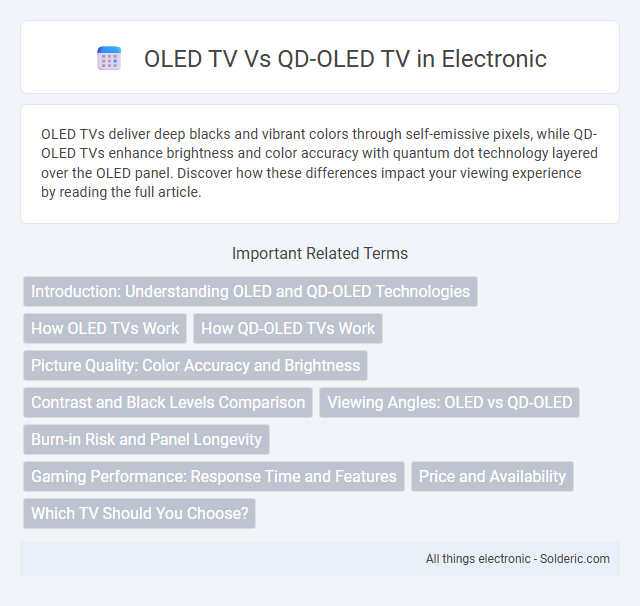OLED TVs deliver deep blacks and vibrant colors through self-emissive pixels, while QD-OLED TVs enhance brightness and color accuracy with quantum dot technology layered over the OLED panel. Discover how these differences impact your viewing experience by reading the full article.
Comparison Table
| Feature | OLED TV | QD-OLED TV |
|---|---|---|
| Display Technology | Organic Light Emitting Diode (OLED) | Quantum Dot Organic Light Emitting Diode (QD-OLED) |
| Brightness | Up to 600 nits | Up to 1000 nits |
| Color Accuracy | Excellent with wide color gamut | Improved, wider gamut & higher color volume |
| Contrast Ratio | Infinite (true blacks) | Infinite (true blacks) |
| Viewing Angles | Wide, minimal color shift | Wide, enhanced color stability |
| Burn-In Risk | Possible with static images | Reduced risk due to quantum dot layer |
| Price Range | High | Higher premium |
| Ideal For | General users, cinema enthusiasts | Gamers, HDR content lovers |
Introduction: Understanding OLED and QD-OLED Technologies
OLED TVs utilize organic light-emitting diodes that produce deep blacks and vibrant colors through self-emissive pixels. QD-OLED technology enhances traditional OLED by integrating quantum dots to deliver brighter images and a wider color gamut, improving overall picture quality. Your choice between OLED and QD-OLED TVs depends on preferences for brightness, contrast, and color accuracy.
How OLED TVs Work
OLED TVs employ organic light-emitting diodes that emit light individually from each pixel when an electric current passes through them, enabling true blacks and infinite contrast ratios. QD-OLED TVs combine quantum dot technology with OLED panels, enhancing color brightness and accuracy by converting blue OLED light into pure red and green hues. This hybrid technology results in higher peak luminance and a wider color gamut compared to traditional OLED displays.
How QD-OLED TVs Work
QD-OLED TVs combine Quantum Dot technology with OLED panels, using blue OLED emitters that excite quantum dots to produce precise red and green colors, enhancing color accuracy and brightness. This hybrid approach allows QD-OLED displays to deliver deeper blacks and wider color gamuts compared to traditional OLED TVs, improving overall picture quality. Your viewing experience benefits from sharper color reproduction and higher peak brightness in various lighting conditions.
Picture Quality: Color Accuracy and Brightness
OLED TVs deliver exceptional picture quality with perfect black levels and outstanding color accuracy due to their self-emissive pixels, resulting in vibrant and true-to-life images. QD-OLED TVs enhance brightness significantly by combining quantum dot technology with OLED panels, offering higher peak luminance and a wider color gamut for more vivid and dynamic visuals. Your viewing experience benefits from the QD-OLED's improved brightness without sacrificing the precise color fidelity characteristic of traditional OLED screens.
Contrast and Black Levels Comparison
OLED TVs deliver exceptional contrast and perfect black levels due to their self-emissive pixels that can turn off completely, resulting in infinite contrast ratios. QD-OLED TVs combine quantum dot technology with OLED panels, enhancing brightness and color volume while maintaining OLED's signature perfect blacks and high contrast. The improved peak brightness of QD-OLEDs contributes to better performance in bright scenes without sacrificing true black reproduction.
Viewing Angles: OLED vs QD-OLED
OLED TVs provide wide viewing angles with consistent color accuracy and brightness, making them ideal for group viewing in varied seating arrangements. QD-OLED TVs enhance this experience by combining quantum dot technology with OLED panels, offering even better color volume and brightness retention at off-angles. Your viewing experience improves with QD-OLED as it reduces color shift and maintains vivid imagery from nearly any position.
Burn-in Risk and Panel Longevity
OLED TVs have an inherent burn-in risk due to their organic materials, leading to potential image retention over time, especially with static content. QD-OLED TVs, integrating quantum dot technology, typically offer improved brightness and color accuracy but still face similar burn-in challenges as traditional OLEDs. To maximize your panel longevity, it is essential to use screen savers, avoid static images for long periods, and adjust brightness settings appropriately.
Gaming Performance: Response Time and Features
OLED TVs offer near-instantaneous response times around 0.1ms, minimizing motion blur and input lag, essential for competitive gaming. QD-OLED TVs maintain similarly fast response times while delivering brighter images and improved color accuracy due to Quantum Dot technology. Both types support features like variable refresh rate (VRR) and Auto Low Latency Mode (ALLM), but QD-OLED's superior peak brightness can enhance HDR gaming experiences in well-lit environments.
Price and Availability
OLED TVs generally offer premium picture quality at a relatively high price point, with wide availability from major brands like LG and Sony. QD-OLED TVs, combining Quantum Dot technology with OLED panels, tend to be pricier due to newer technology and limited production, primarily available through select models from Samsung. Your choice may depend on budget and access, as OLED TVs are more commonly found in various price ranges, while QD-OLED TVs remain a premium, less accessible option.
Which TV Should You Choose?
OLED TVs deliver perfect blacks and vibrant colors with exceptional viewing angles, ideal for dark-room environments and cinematic experiences. QD-OLED TVs enhance color accuracy and brightness using quantum dot technology, making them suitable for well-lit rooms and gaming with HDR content. Choosing between OLED and QD-OLED depends on your lighting conditions and preference for cinematic depth versus vivid color intensity.
OLED TV vs QD-OLED TV Infographic

 solderic.com
solderic.com